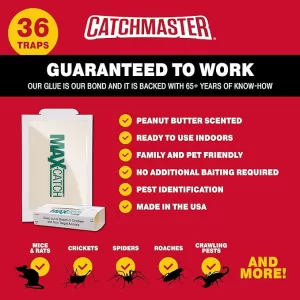What Does Roach Rash Look Like?
 Cockroach infestations can lead to various health issues, one of which is the development of a skin condition known as “roach rash.” Understanding what roach rash looks like and how to treat it can help you manage this uncomfortable reaction and prevent further exposure. In this article, we’ll explore the causes, symptoms, and treatments for roach rash, as well as tips for preventing cockroach infestations in your home.
Cockroach infestations can lead to various health issues, one of which is the development of a skin condition known as “roach rash.” Understanding what roach rash looks like and how to treat it can help you manage this uncomfortable reaction and prevent further exposure. In this article, we’ll explore the causes, symptoms, and treatments for roach rash, as well as tips for preventing cockroach infestations in your home.
What is Roach Rash?
Causes of Roach Rash
Roach rash is a skin reaction caused by allergens present in cockroach droppings, saliva, and shed skins. When these allergens come into contact with the skin, they can trigger an allergic reaction, leading to the development of a rash.
Symptoms of Roach Rash
Appearance
- Redness: The affected area may appear red and inflamed.
- Bumps: Small, raised bumps or welts can develop on the skin.
- Itching: The rash is often accompanied by intense itching, which can lead to scratching and further irritation.
- Swelling: In some cases, the skin around the rash may swell.
Common Locations
Roach rash can occur anywhere on the body, but it is most commonly found on areas that come into direct contact with contaminated surfaces, such as:
- Hands and Arms: From touching contaminated surfaces.
- Face and Neck: From allergens settling on the skin.
- Legs and Feet: From walking barefoot on contaminated floors.
How to Identify Roach Rash
Visual Identification
Roach rash can be identified by its characteristic appearance:
- Clustered Bumps: The rash often appears as clusters of small, itchy bumps.
- Localized Redness: The area around the bumps is typically red and irritated.
- Scratching Marks: Due to intense itching, there may be visible scratch marks or broken skin.
When to Seek Medical Attention
If you experience severe symptoms, such as difficulty breathing, swelling of the face or throat, or a widespread rash, seek medical attention immediately. These could be signs of a more serious allergic reaction.
Treating Roach Rash
Home Remedies
- Cold Compress: Apply a cold compress to the affected area to reduce itching and swelling.
- Oatmeal Bath: Taking an oatmeal bath can help soothe irritated skin.
- Aloe Vera: Applying aloe vera gel can provide relief from itching and promote healing.
Over-the-Counter Treatments
- Antihistamines: Oral antihistamines can help reduce itching and allergic reactions.
- Hydrocortisone Cream: Topical hydrocortisone cream can reduce inflammation and itching.
- Calamine Lotion: Applying calamine lotion can provide a cooling effect and reduce itching.
Professional Medical Treatment
For severe or persistent cases, consult a healthcare professional. They may prescribe stronger medications or provide additional treatments to manage the symptoms.
Preventing Roach Rash
Maintaining Cleanliness
- Regular Cleaning: Clean your home regularly to remove food crumbs, spills, and other attractants.
- Proper Food Storage: Store food in sealed containers and dispose of garbage regularly.
Controlling Humidity
- Fix Leaks: Repair any leaky faucets and pipes to reduce moisture levels.
- Use Dehumidifiers: In damp areas, use dehumidifiers to lower humidity levels.
Sealing Entry Points
- Close Off Cracks and Gaps: Use caulk and weather stripping to seal cracks and gaps where cockroaches might enter.
- Install Screens: Ensure that windows and vents have tight-fitting screens to keep cockroaches out.
Professional Pest Control
For severe infestations, consider hiring a professional pest control service. Professionals can provide comprehensive inspections and targeted treatments to effectively manage and eliminate cockroach populations.
Roach rash is an uncomfortable skin condition caused by allergens from cockroaches. Recognizing the symptoms and knowing how to treat and prevent it can help you manage this issue effectively. By maintaining cleanliness, controlling humidity, and sealing entry points, you can reduce the risk of cockroach infestations and the associated health problems.
If you suspect a cockroach infestation in your home, take immediate steps to address it. Regular cleaning, moisture control, and sealing entry points are key to preventing infestations. If you need assistance, don’t hesitate to contact a professional pest control service for expert help.
- The Life Span of a Cockroach
- Do Cockroaches Eat Clothes?
- Do Cockroaches Have Teeth?
- Shrimps and Cockroaches
- Will Sleeping with the Light On Keep Cockroaches Away?
- How to get roaches out of your car overnight
- Do Cockroaches Feel Pain?
- How Many Legs Do Cockroaches Have?
- Comparing Cockroach Eggs Size for Different Types of Cockroaches
- Identifying a Cockroach Bite on the Lips or Face
- Black Water Bug Identification and Control
- Why Do Water Bugs Come Out At Night?
- What Does Roach Rash Look Like?
- Can Cockroaches Bite Your Eyelid?
- Can Cockroaches Live in Your Balls?
- How did cockroaches get their name?
- Why Do Cockroaches Shed Their Skin?
- What Smell do Palmetto Bugs Hate?
- Baby Palmetto Bug: Identification and Control
- Cockroach Eggs vs Poop: How to Tell the Difference
- How to Get Rid of Water Bugs
- How Long Can a Cockroach Live Without Air?
- The Lifecycle of the German Cockroach: From Egg to Adult
- Do Mice Eat Roaches
- Wood Roach vs. Cockroach

